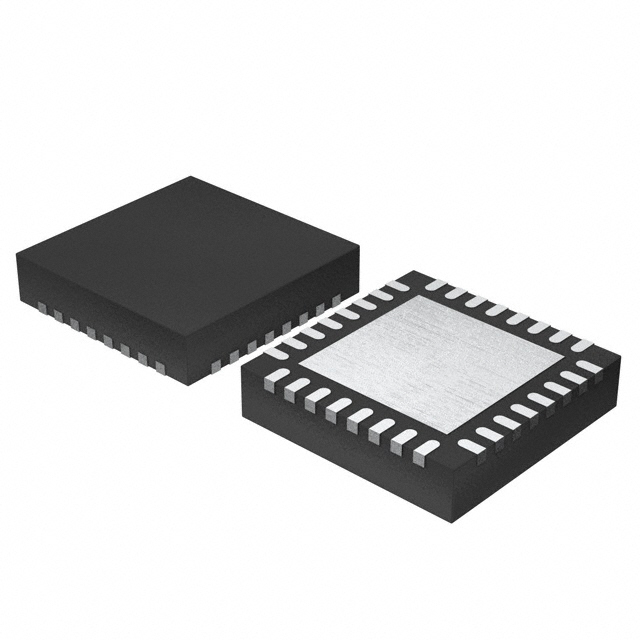Viz Specifikace pro podrobnosti o produktu.

LTC3729EUH#PBF
Product Overview
Category
LTC3729EUH#PBF belongs to the category of integrated circuits (ICs) specifically designed for power management applications.
Use
This product is primarily used in various power management systems, including but not limited to voltage regulation, battery charging, and DC-DC conversion.
Characteristics
- High efficiency: The LTC3729EUH#PBF offers excellent power conversion efficiency, ensuring minimal energy loss during operation.
- Wide input voltage range: It can handle a wide range of input voltages, making it suitable for diverse applications.
- Robust design: This IC is built with high-quality components, ensuring reliability and durability.
- Advanced protection features: It incorporates various protection mechanisms such as overvoltage, undervoltage, and overcurrent protection, enhancing system safety.
Package
The LTC3729EUH#PBF comes in a compact and industry-standard 28-pin QFN package. This package provides efficient heat dissipation and ease of integration into different circuit designs.
Essence
The essence of LTC3729EUH#PBF lies in its ability to efficiently manage power in a wide range of applications, providing stable and regulated output voltages.
Packaging/Quantity
This product is typically available in reels containing a specific quantity of ICs, usually 250 or 1000 units per reel, depending on the manufacturer's packaging specifications.
Specifications
- Input Voltage Range: 4V - 36V
- Output Voltage Range: 0.6V - 34V
- Maximum Output Current: 10A
- Switching Frequency: 200kHz - 2MHz
- Operating Temperature Range: -40°C to 125°C
- Control Interface: SPI/I2C
Detailed Pin Configuration
- VIN: Input voltage pin
- GND: Ground pin
- VOUT: Output voltage pin
- FB: Feedback pin for regulating output voltage
- EN: Enable pin for turning the IC on/off
- PGND: Power ground pin
- SS: Soft-start pin for controlling startup behavior
- CLK: Clock input pin for synchronous operation
- SYNC: Synchronization pin for external clock synchronization
- ...
(Note: Detailed pin configuration continues for all 28 pins)
Functional Features
- High-efficiency power conversion
- Wide input voltage range
- Programmable output voltage
- Overvoltage and undervoltage protection
- Overcurrent protection
- Soft-start functionality for controlled startup
- Synchronous operation for improved efficiency
- External clock synchronization capability
Advantages and Disadvantages
Advantages
- High efficiency leads to reduced energy loss
- Wide input voltage range allows for versatile applications
- Robust design ensures reliability
- Advanced protection features enhance system safety
- Compact package facilitates integration into various circuit designs
Disadvantages
- Requires additional external components for complete power management system implementation
- Complex pin configuration may require careful attention during circuit design and layout
Working Principles
The LTC3729EUH#PBF operates based on a switching regulator topology, specifically a buck-boost converter. It utilizes high-frequency switching to efficiently convert input voltage to the desired output voltage level. The feedback mechanism continuously monitors the output voltage and adjusts the duty cycle of the internal switches to maintain a stable output.
Detailed Application Field Plans
The LTC3729EUH#PBF finds extensive application in various fields, including: 1. Industrial automation systems 2. Automotive electronics 3. Renewable energy systems 4. Telecommunications equipment 5. Battery-powered devices 6. LED lighting systems 7. Portable electronic devices 8. Medical equipment 9. Robotics 10. Aerospace and defense systems
Detailed and Complete Alternative Models
- LTC3729EUD#PBF
- LTC3729EG#PBF
- LTC3729EUH#TRPBF
- LTC3729EUD#TRPBF
- LTC3729EG#TRPBF
- ...
(Note: List continues with alternative models)
This concludes the encyclopedia entry for LTC3729EUH#PBF, providing comprehensive information about its product category, use, characteristics, package, specifications, pin configuration, functional features, advantages and disadvantages, working principles, application field plans, and alternative models.
Seznam 10 běžných otázek a odpovědí souvisejících s aplikací LTC3729EUH#PBF v technických řešeních
Sure! Here are 10 common questions and answers related to the application of LTC3729EUH#PBF in technical solutions:
Q: What is LTC3729EUH#PBF? A: LTC3729EUH#PBF is a high-performance synchronous step-down DC/DC controller IC manufactured by Linear Technology (now part of Analog Devices). It is commonly used in power management applications.
Q: What is the input voltage range supported by LTC3729EUH#PBF? A: The input voltage range supported by LTC3729EUH#PBF is typically between 4.5V and 36V.
Q: What is the output voltage range that can be achieved using LTC3729EUH#PBF? A: The output voltage range that can be achieved using LTC3729EUH#PBF depends on the external components used, but it can typically range from 0.6V to 34V.
Q: What is the maximum output current that LTC3729EUH#PBF can handle? A: LTC3729EUH#PBF can handle a maximum output current of up to 20A, depending on the design and thermal considerations.
Q: Does LTC3729EUH#PBF support synchronous rectification? A: Yes, LTC3729EUH#PBF supports synchronous rectification, which improves efficiency by reducing power losses.
Q: Can LTC3729EUH#PBF operate in a wide temperature range? A: Yes, LTC3729EUH#PBF is designed to operate in a wide temperature range, typically from -40°C to 125°C.
Q: Is LTC3729EUH#PBF suitable for battery-powered applications? A: Yes, LTC3729EUH#PBF is suitable for battery-powered applications as it can efficiently regulate the voltage from a wide input range.
Q: Does LTC3729EUH#PBF have built-in protection features? A: Yes, LTC3729EUH#PBF has various built-in protection features such as overvoltage protection, undervoltage lockout, and thermal shutdown.
Q: Can LTC3729EUH#PBF be used in parallel to increase output current? A: Yes, LTC3729EUH#PBF can be used in parallel with other LTC3729EUH#PBF controllers to increase the output current capability.
Q: Are there any application notes or reference designs available for LTC3729EUH#PBF? A: Yes, Analog Devices provides application notes and reference designs that can help users understand and implement LTC3729EUH#PBF in their technical solutions effectively.
Please note that the answers provided here are general and may vary depending on specific design considerations and requirements. It is always recommended to refer to the datasheet and relevant documentation for accurate information.

